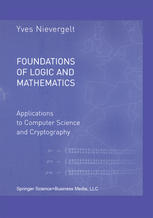

Most ebook files are in PDF format, so you can easily read them using various software such as Foxit Reader or directly on the Google Chrome browser.
Some ebook files are released by publishers in other formats such as .awz, .mobi, .epub, .fb2, etc. You may need to install specific software to read these formats on mobile/PC, such as Calibre.
Please read the tutorial at this link: https://ebookbell.com/faq
We offer FREE conversion to the popular formats you request; however, this may take some time. Therefore, right after payment, please email us, and we will try to provide the service as quickly as possible.
For some exceptional file formats or broken links (if any), please refrain from opening any disputes. Instead, email us first, and we will try to assist within a maximum of 6 hours.
EbookBell Team

0.0
0 reviewsThis modem introduction to the foundations of logic, mathematics, and computer science answers frequent questions that mysteriously remain mostly unanswered in other texts: • Why is the truth table for the logical implication so unintuitive? • Why are there no recipes to design proofs? • Where do these numerous mathematical rules come from? • What are the applications of formal logic and abstract mathematics? • What issues in logic, mathematics, and computer science still remain unresolved? Answers to such questions must necessarily present both theory and significant applica tions, which explains the length of the book. The text first shows how real life provides some guidance for the selection of axioms for the basis of a logical system, for instance, Boolean, classical, intuitionistic, or minimalistic logic. From such axioms, the text then derives de tailed explanations of the elements of modem logic and mathematics: set theory, arithmetic, number theory, combinatorics, probability, and graph theory, with applications to computer science. The motivation for such detail, and for the organization of the material, lies in a continuous thread from logic and mathematics to their uses in everyday life.